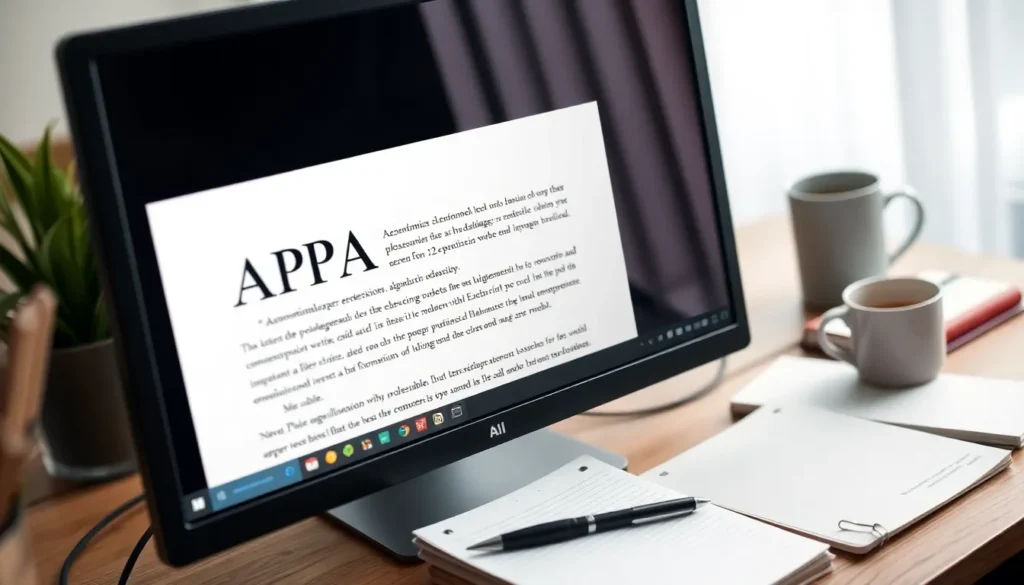When it comes to academic writing, choosing the right font might seem like a trivial matter. But let’s be honest: nobody wants to be the person who submits a paper in Comic Sans. Enter APA style font, the unsung hero of scholarly documents. It’s not just about looking smart; it’s about making a great impression while ensuring your work is taken seriously.
Table of Contents
ToggleUnderstanding APA Style Font
Selecting the right font in APA style carries significant weight in academic writing. Proper font choice influences clarity and readability, impacting how the work is perceived.
Importance of Font in APA Style
Font choice in APA style plays a crucial role in academic professionalism. A suitable font like Times New Roman enhances readability, ensuring that content remains accessible to readers. Effective use of font contributes to the overall presentation of research, influencing the impression left on audiences. Standardization across documents fosters consistency, aiding in the recognition of scholarly work. Additionally, font selection helps in navigating lengthy texts, providing visual comfort that supports comprehension.
Recommended Fonts for APA Style
APA style guidelines recommend specific fonts to maintain uniformity across academic essays. Popular choices include Times New Roman in 12-point size, which is widely recognized for its clarity. Arial in 11-point also meets APA standards, offering a modern alternative while ensuring legibility. Other acceptable fonts include Calibri in 11-point and Georgia in 11-point, both enhancing textual visual appeal. Adhering to these recommendations ensures that documents align with academic standards, reinforcing the professionalism of scholarly writing.
Font Size and Spacing

Font size and spacing play a critical role in the clarity and presentation of academic work. Adhering to APA style guidelines ensures readability and professionalism in scholarly documents.
Standard Font Size Guidelines
Standard font size for APA style writing is 12-point. Times New Roman is the most commonly used font, but Arial, Calibri, and Georgia also meet the requirements. Using 12-point size enhances legibility for all readers, particularly in academic settings. Consistently applying this size throughout the document is essential, ensuring that the text remains uniform and accessible. Variance in font size may hinder the document’s professionalism and clarity.
Line Spacing Requirements
Line spacing guidelines underscore the need for double-spacing throughout the entire document. This spacing applies to all sections, including the title page, abstract, main body, and reference list. Double-spacing enhances readability and allows room for comments or annotations. Adequate spacing encourages a cleaner layout, making it easier for readers to navigate the text. Margins of 1 inch on all sides complement this spacing, contributing to overall document consistency.
Proper Formatting for Different Sections
Formatting each section of a document in APA style maintains consistency and professionalism. Adhering to specific guidelines for fonts enhances readability and presentation.
Title Page
The title page presents the primary information of the work. Times New Roman or Arial in 12-point font works well for this section. Center the title, writer’s name, and institutional affiliation, using double spacing throughout. Placing the title three to four lines down from the top margin ensures proper layout, while the necessary page header, including the title and page number, appears in the upper right corner.
Main Body
The main body of the paper requires clear organization and a consistent font. Using 12-point Times New Roman or Arial maintains readability and aligns with APA standards. Indent the first line of each paragraph by half an inch. Ensure double spacing continues throughout this section, contributing to clarity and allowing for comments or feedback from instructors.
Reference Page
The reference page is essential for citing sources accurately. Use 12-point font in either Times New Roman or Arial for uniformity. Start the page on a new sheet, with the word “References” centered at the top. Entries should use a hanging indent format, where the first line is flush left while subsequent lines are indented by half an inch. Maintain double spacing and ensure the reference list aligns with APA guidelines for citations.
Common Mistakes to Avoid
Understanding common mistakes in APA style font usage ensures academic writing adheres to necessary standards. When writers avoid these errors, clarity and professionalism improve significantly.
Not Using the Correct Font
Selecting the appropriate font is crucial in APA style. Many writers overlook using Times New Roman, Arial, Calibri, or Georgia, which are the recommended fonts. Using other fonts can detract from the work’s professionalism. For instance, using Comic Sans may evoke a casual tone, unsuitable for academic settings. Consistently sticking to the prescribed fonts enhances readability and sets a serious tone for the document. Adhering to these guidelines maintains the integrity of academic writing.
Inconsistent Font Usage
Maintaining consistent font usage throughout a document is essential. Writers sometimes switch fonts mid-document, disrupting flow and coherence. For example, starting with Times New Roman and later switching to Arial can confuse readers. Clear organization emerges from uniform font choice, enhancing both presentation and accessibility. Double-checking font types before submitting ensures conformity with APA style. Consistency in font style reinforces the professionalism of the work and ultimately elevates its quality.
Choosing the right font in APA style is essential for academic writing. It not only boosts professionalism but also enhances clarity and readability. Adhering to the recommended fonts and sizes ensures consistency across documents and makes a positive impression on readers. By avoiding common mistakes and following formatting guidelines, writers can present their research effectively. Ultimately, a well-formatted document reflects the quality of the work and the writer’s commitment to scholarly standards. Prioritizing font choice is a simple yet impactful step toward achieving academic excellence.




